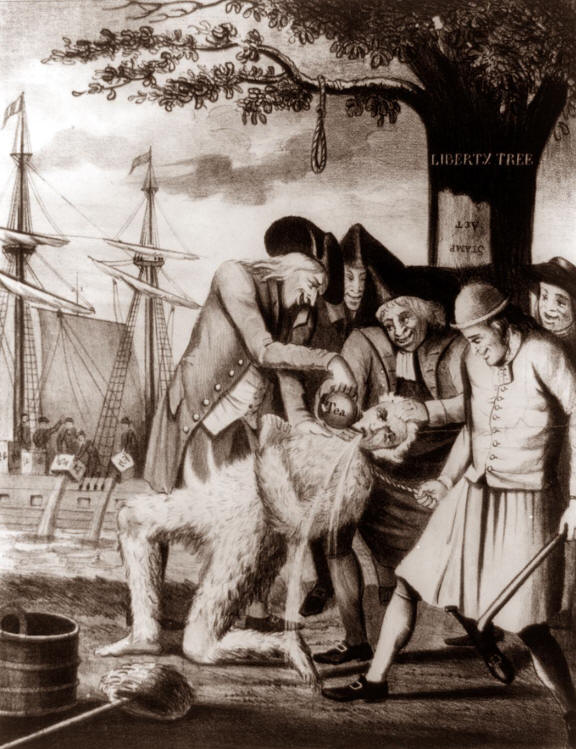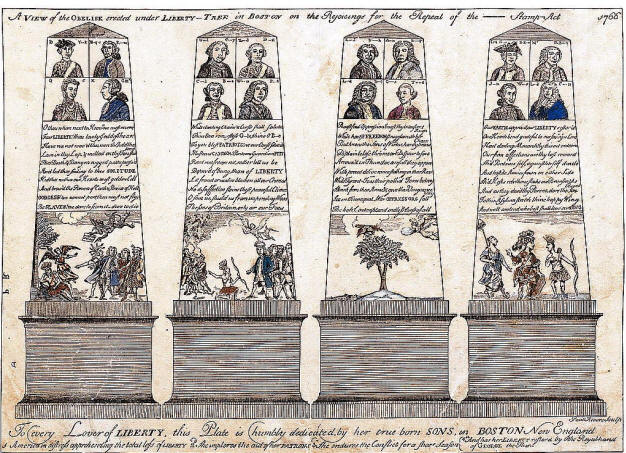Liberty Tree
|
|
This Site:
|
Sons of Liberty tarring & feathering British Loyalist Under the Liberty Tree Liberty Tree. The original Liberty Tree, in Boston, was not on Boston Common. It was the largest one of a grove of beautiful elms which stood in Hanover Square, at the corner of Orange (now Washington) and Essex streets, opposite the Boyleston Market. Its exact site is marked by a building. on the front of which is a relief figure of the tree in granite and the inscription " Sons of Liberty –1766. Independence of Our Country–1776." This elm was called " Liberty Tree" because the Sons of Liberty held their meetings under it, and the ground below was called "Liberty Hall." The first meeting of this society was held there some time in 1765. A pole fastened to the trunk of the tree rose far above the top-most branch, and a red flag floating from it was an understood signal to call together the fearless Sons of Liberty. This society held many meetings here during the next ten years, and placards addressed to the people were nailed to the tree, and inscribed banners were suspended from its limbs. They had a board fastened to the tree with the inscription, "This tree was planted in 1614, and pruned by order of the Sons of Liberty, Feb. 14, 1776." On Nov. 20, 1767, a seditious handbill was fixed to the tree, exhorting the Sons of Liberty to rise and fight against the country's oppressors; it declared that they would be joined by legions of their countrymen, that the tyrant would be driven from the land, and generations to come would bless them, while if they neglected this opportunity to free their country they would be cursed to all eternity. In June, 1768, a red flag was raised over the tree, and a second appeal to the Sons of Liberty to rise against the British was affixed in the form of a a handbill to its trunk. The anniversary of the rising against the Stamp Act was observed Aug. 14, 1773, by a meeting under this tree. On Nov. 3 following there was an immense gathering under this tree again, at which a resolution was passed concerning the tea-ships which were known to be on their way to Boston, ordering the consignees of the cargoes not to sell them on American soil, but to return them promptly to London in the same vessels in which they had been shipped. The ultimate result of this meeting was the "Boston Tea party" of Dec. 6, 1773, when 340 chests of tea were poured into the Boston Harbor. In May, 1774, British troops under Gage were quartered in Boston, the port was closed, and all public meetings were forbidden. The gatherings of the Sons of Liberty were, therefore, made in secret during the next two years, but the Liberty Tree retained its name, and probably witnessed more than one midnight meeting. In the winter of 1775–76 the British soldiery, to whom the popular name of this tree rendered it an object of hatred, cut down this magnificent elm and converted it into fourteen cords of firewood. This act of destruction was greatly resented by the people. Engraving by Paul Revere of the Monument constructed under the Liberty Tree |
|
|
||
|
|
Site Copyright 2003-2018 Son of the South. For Questions or comments about this collection, contact: paul@sonofthesouth.net |
|
|
Are you Scared and Confused? Read My Snake Story, a story of hope and encouragement, to help you face your fears. |
||

